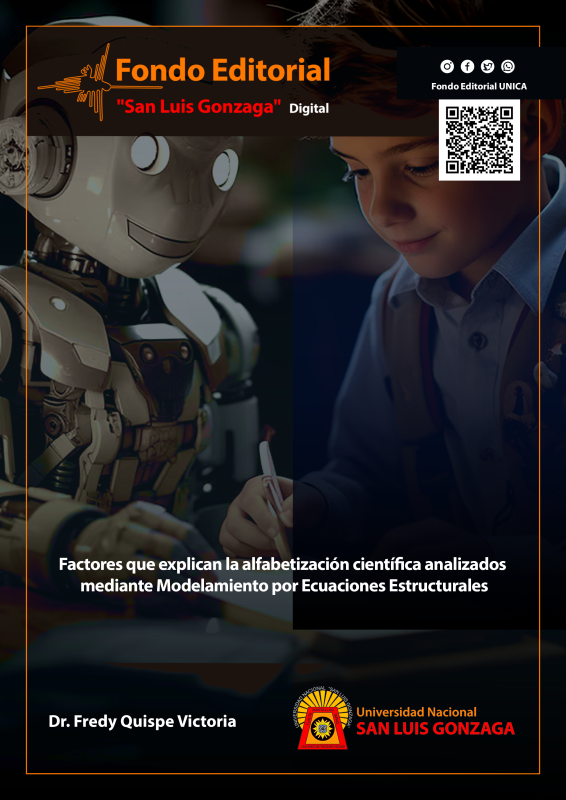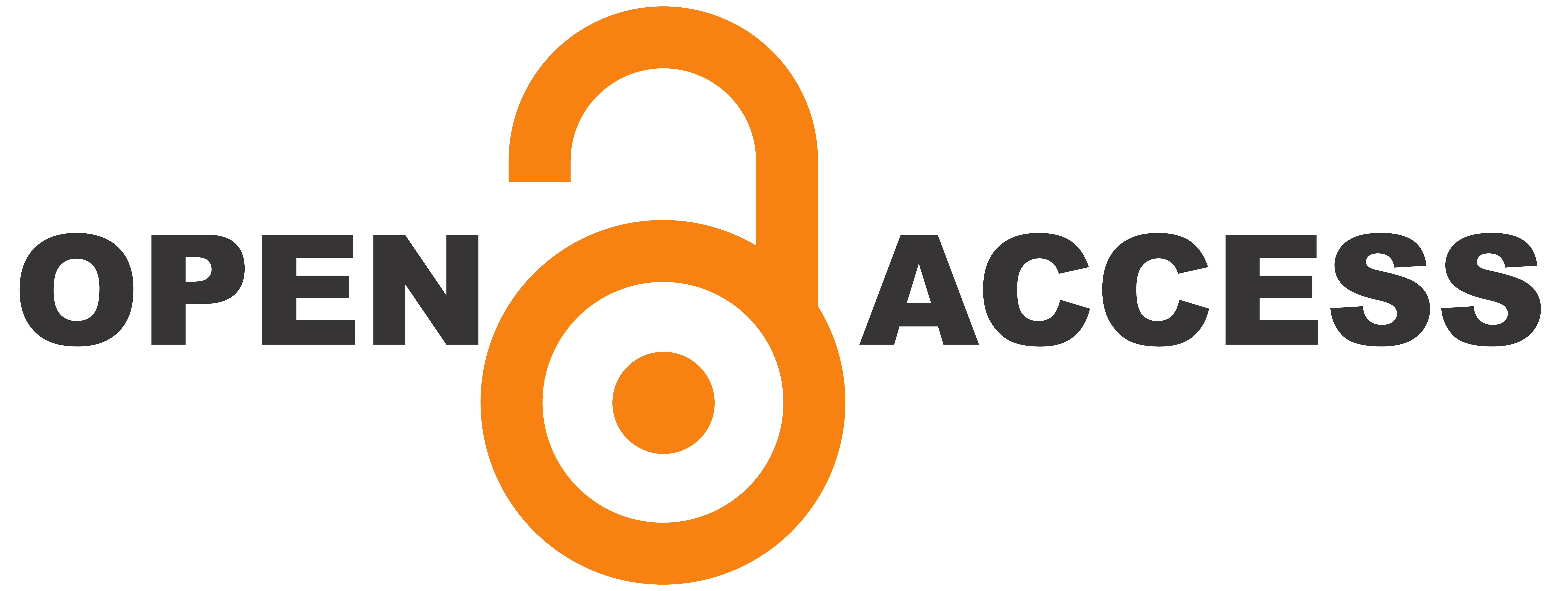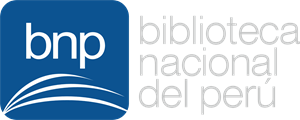Factores que explican la alfabetización científica analizados mediante Modelamiento por Ecuaciones Estructurales
Palabras clave:
alfabetización, modelamiento, ecuaciones estructuralesSinopsis
Un adecuado nivel de alfabetización científica es uno de los propósitos de aprendizaje más valorados de todo sistema educativo al culminar la trayectoria de formación de sus estudiantes. El Ministerio de Educación (MINEDU) ha declarado explícitamente este propósito en el perfil de egreso, bajo los siguientes términos: “El estudiante indaga y comprende el mundo natural y artificial utilizando conocimientos científicos en diálogo con saberes locales para mejorar la calidad de vida y cuidando la naturaleza.” (MINEDU, 2017a, p. 16).
Siendo la alfabetización científica una competencia general cuyo nivel de desempeño depende, para su formación, de ciertos factores que pueden ser de tipo psicológico, pedagógico y sociocultural; se han desarrollado algunos intentos por comprender los factores y mecanismos que conducen a un mejor desempeño de la alfabetización científica, el MINEDU ha analizado los factores asociados al desarrollo de la competencia científica en estudiantes peruanos según los datos de PISA 2015, reconociendo en dicho análisis la importancia de las actitudes relacionadas con la ciencia, las creencias científicas, estrategias pedagógicas y contextos para el aprendizaje de la ciencia (MINEDU, 2020).
En un estudio con big data, Lizhnina y Kismihók (2022) construyeron modelos lineales jerárquicos (HLM) para explorar las relaciones entre las actitudes hacia las TIC y la alfabetización matemática y científica. Estos investigadores hallaron que la autonomía de las TIC fue una variable importante en los modelos RF (Algoritmos de Bloques Aleatorios), y las asociaciones entre esta actitud y las puntuaciones de alfabetización en HLM (Modelos Lineales Jerárquicos) fueron significativas y positivas, mientras que, para otras actitudes hacia las TIC, las asociaciones fueron negativas (TIC en la interacción social) o no significativas (competencia TIC e interés TIC).
Referencias
Aditomo, A., & Klieme, E. (2020). Forms of inquiry-based science instruction and their relations with learning outcomes: Evidence from high and low-performing education systems. International Journal of Science Education, 42(4), 504-525. Scopus. https://doi.org/10.1080/09500693.2020.1716093
Aguaded, I., Civila, S., & Vizcaíno-Verdú, A. (2022). Paradigm changes and new challenges for media education: Review and science mapping (2000-2021). Profesional de la Informacion, 31(6). Scopus. https://doi.org/10.3145/epi.2022.nov.06
Aguirre, M., & Llaque, P. (2005). Redacción Académica. Fundamentos y Estrategias. UPC.
Ahmed, W., & Mudrey, R. R. (2019). The role of motivational factors in predicting STEM career aspirations. International Journal of School and Educational Psychology, 7(3), 201-214. Scopus. https://doi.org/10.1080/21683603.2017.1401499
Aiken, L. (2003). Tests psicológicos y evaluación (11va. Ed.). Pearson Educación.
Akdogdu-Yildiz, E., Demir, M. C., & Gelbal, S. (2022). Investigating Factors Affecting Scientific Literacy with Structural Equation Modeling and Multilevel Structural Equation Modeling: Case of PISA 2015. Cukurova University Faculty of Education Journal, 51(2), 795-824. https://doi.org/10.14812/cufej.933101
Aldás, J., & Uriel, E. (2017). Análisis multivariante aplicado con R (2da. Ed.). Alfacentaruo.
Allison, E., & Goldston, M. J. (2018). Modern Scientific Literacy: A Case Study of Multiliteracies and Scientific Practices in a Fifth Grade Classroom. Journal of Science Education and Technology, 27(3), 270-283. https://doi.org/10.1007/s10956-017-9723-z
Al-Rsa’i, M. S. (2013). Promoting scientific literacy by using ICT in science teaching. International Education Studies, 6(9), 175-186. Scopus. https://doi.org/10.5539/ies.v6n9p175
American Psychological Association. (2009). APA. Diccionario conciso de Psicología. El Manual Moderno.
Anastasi, A., & Urbina, S. (1998). Tests psicológicos (7ma Ed.). Prentice Hall.
Areepattamannil, S., & Santos, I. M. (2019). Adolescent students’ perceived information and communication technology (ICT) competence and autonomy: Examining links to dispositions toward science in 42 countries. Computers in Human Behavior, 98, 50-58. https://doi.org/10.1016/j.chb.2019.04.005
Arpacı, S., Mercan, F. Ç., & Arıkan, S. (2021). The differential relationships between PISA 2015 science performance and, ICT availability, ICT use and attitudes toward ICT across regions: Evidence from 35 countries. Education and Information Technologies, 26(5), 6299-6318. Scopus. https://doi.org/10.1007/s10639-021-10576-2
Ato, M., & Vallejo, G. (2015). Diseños de investigación en Psicología. Ediciones Pirámide.
Barbero, M. I. (2015). Principios básicos para la construcción de instrumentos de medición psicológica. En Psicometría (pp. 51-101). Editorial Sanz y Torres, S. L.
Bawden, D. (2002). Revisión de los conceptos de alfabetización informacional y alfabetización digital. anales de documentación, 5(0), 361-408.
Bazán-Ramírez, A., Hernández-Padilla, E., Bazán-Ramírez, W., & Tresierra-Ayala, M. (2022). Effects of Opportunities to Learn on Peruvian Students’ Science Achievement in Program for International Student Assessment 2015. Frontiers in Education, 7. Scopus. https://doi.org/10.3389/feduc.2022.897473
Bloom, B. (1990). Taxonomía de los objetivos de la educación. La clasificación de las metas educacionales (Décima Edición). Editorial el Ateneo.
Bonanati, S., & Buhl, H. M. (2022). The Digital Home Learning Environment and Its Relation to Children’s ICT Self-Efficacy. Learning Environments Research, 25(2), 485-505. https://doi.org/10.1007/s10984-021-09377-8
Bunge, M. (1997). La Investigación Científica. Su Estrategia y su Filosofía (4ta. Edición). Editorial Ariel.
Cea D’Ancona, M. A. (2012). Metodología cuantitativa. Estrategias y técnicas de investigación social. Síntesis.
Chin, W. W. (1998). The partial least squares approach for structural equation modeling. En Modern methods for business research (pp. 295-336). Lawrence Erlbaum Associates Publishers.
Churchill, G. A. (1979). A Paradigm for Developing Better Measures of Marketing Constructs. Journal of Marketing Research, 16(1), 64-73. https://doi.org/10.2307/3150876
Clavel, J. G., García Crespo, F. J., & Sanz San Miguel, L. (2022). Rising above their circumstances: What makes some disadvantaged East and South-East Asian students perform far better in science than their background predicts? Asia Pacific Journal of Education, 42(4), 714-729. Scopus. https://doi.org/10.1080/02188791.2021.1886905
Cohen, R. J., & Swerdlik, M. E. (2006). Pruebas y evaluación psicológica. McGraw Hill Interamericana.
Coon, D., & Mitterer, J. (2010). Introducción a la Psicología. El acceso a la mente y la conducta (20 Edición). CENGAGE Learning.
Courtney, M., Karakus, M., Ersozlu, Z., & Nurumov, K. (2022). The Influence of ICT Use and Related Attitudes on Students’ Math and Science Performance: Multilevel Analyses of the Last Decade’s PISA Surveys. Large-Scale Assessments in Education, 10. https://doi.org/10.1186/s40536-022-00128-6
Davis, S., & Paladino, J. (2008). Psicología (5ta. Ed.). Pearson Educación.
DeBoer, G. E. (2000). Scientific literacy: Another look at its historical and contemporary meanings and its relationship to science education reform. Journal of Research in Science Teaching, 37(6), 582-601. https://doi.org/10.1002/1098-2736(200008)37:6<582::AID-TEA5>3.0.CO;2-L
Deci, E. L., & Ryan, R. M. (2000). The «What» and «Why» of Goal Pursuits: Human Needs and the Self-Determination of Behavior. Psychological Inquiry, 11(4), 227-268. https://doi.org/10.1207/S15327965PLI1104_01
Diaz Moreno, N., Caparros Martin, E., & Sierra Nieto, J. E. (2019). Using socioscientific issues as an educational tool to develop scientific literacy. Ijeri-International Journal of Educational Research and Innovation, 12, 261-281.
Dong, F., & Kula, M. C. (2022). Digital device use and scientific literacy: An examination using Programme for International Student assessment (PISA) 2015 data. Education Economics. Scopus. https://doi.org/10.1080/09645292.2022.2063797
Erdogdu, F., & Erdogdu, E. (2015). The impact of access to ICT, student background and school/home environment on academic success of students in Turkey: An international comparative analysis. Computers & Education, 82, 26-49. https://doi.org/10.1016/j.compedu.2014.10.023
Fensham, P. (2008). Science Education Policy-making. UNESCO. http://efepereth.wdfiles.com/local--files/science-education/Science_Education_Policy-making.pdf
Fornell, C., & Larcker, D. F. (1981). Evaluating Structural Equation Models with Unobservable Variables and Measurement Error. Journal of Marketing Research, 18(1), 39-50. https://doi.org/10.2307/3151312
Gil-Madrona, P., Martínez-López, M., & Sáez-Sánchez, M.-B. (2019). Objective and subjective factors associated with Spanish students’ performance in science in PISA 2015 / Factores objetivos y subjetivos asociados al rendimiento del alumnado español en ciencias en PISA 2015. Culture and Education, 31(4), 671-715. https://doi.org/10.1080/11356405.2019.1656485
Gold, A. H., Malhotra, A., & Segars, A. H. (2001). Knowledge Management: An Organizational Capabilities Perspective. Journal of Management Information Systems, 18(1), 185-214. https://doi.org/10.1080/07421222.2001.11045669
Grabau, L. J., & Ma, X. (2017). Science Engagement and Science Achievement in the Context of Science Instruction: A Multilevel Analysis of U.S. Students and Schools. International Journal of Science Education, 39(8), 1045-1068.
Guo, Q., Qiao, C., & Ibrahim, B. (2022). The Mechanism of Influence between ICT and Students’ Science Literacy: A Hierarchical and Structural Equation Modelling Study. Journal of Science Education and Technology, 31(2), 272-288.
Hair, J., & Alamer, A. (2022). Partial Least Squares Structural Equation Modeling (PLS-SEM) in second language and education research: Guidelines using an applied example. Research Methods in Applied Linguistics, 1(3), 100027. https://doi.org/10.1016/j.rmal.2022.100027
Hair, J. F., Ringle, C. M., & Sarstedt, M. (2011). PLS-SEM: Indeed a Silver Bullet. Journal of Marketing Theory and Practice, 19(2), 139-152. https://doi.org/10.2753/MTP1069-6679190202
He, J., Barrera-Pedemonte, F., & Buchholz, J. (2019). Cross-Cultural Comparability of Noncognitive Constructs in TIMSS and PISA. Assessment in Education: Principles, Policy & Practice, 26(4), 369-385.
Henseler, J., Ringle, C. M., & Sarstedt, M. (2015). A new criterion for assessing discriminant validity in variance-based structural equation modeling. Journal of the Academy of Marketing Science, 43(1), 115-135. https://doi.org/10.1007/s11747-014-0403-8
Henseler, J., Ringle, C. M., & Sinkovics, R. R. (2009). The use of partial least squares path modeling in international marketing. En R. R. Sinkovics & P. N. Ghauri (Eds.), New Challenges to International Marketing (Vol. 20, pp. 277-319). Emerald Group Publishing Limited. https://doi.org/10.1108/S1474-7979(2009)0000020014
Hernández, R., Fernández, C., & Baptista, P. (2014). Metodología de la investigación (6ta. Edición). McGraw Hill Interamericana.
Hernández, R., Médez, S., Mendoza, C. P., & Cuevas, A. (2017). Fundamentos de investigación. McGraw-Hill Educación.
Hofverberg, A., Eklöf, H., & Lindfors, M. (2022). Who Makes an Effort? A Person-Centered Examination of Motivation and Beliefs as Predictors of Students’ Effort and Performance on the PISA 2015 Science Assessment. Frontiers in Education, 6. Scopus. https://doi.org/10.3389/feduc.2021.791599
Holgado, F. P., Suárez, J. C., & Morata, M. de los Á. (2019). Modelos de Ecuaciones estructurales, desde el Path Analysis al Análisis Multigrupo. Sanz y Torres.
Hu, X., Gong, Y., Lai, C., & Leung, F. K. S. (2018). The relationship between ICT and student literacy in mathematics, reading, and science across 44 countries: A multilevel analysis. Computers and Education, 125, 1-13. Scopus. https://doi.org/10.1016/j.compedu.2018.05.021
Huang, S., Jiang, Y., Yin, H., & Jong, M. S. (2021). Does ICT use matter? The relationships between students’ ICT use, motivation, and science achievement in East Asia. Learning and Individual Differences, 86, 101957. https://doi.org/10.1016/j.lindif.2020.101957
Kampa, N., Scherer, R., Saß, S., & Schipolowski, S. (2021). The relation between science achievement and general cognitive abilities in large-scale assessments. Intelligence, 86. Scopus. https://doi.org/10.1016/j.intell.2021.101529
Kerlinger, F., & Lee, H. (2002). Investigación del comportamiento. (3ra. Ed.). McGraw-Hill.
Lent, R. W., Hackett, G., & Brown, S. D. (2004). Una perspectiva Social Cognitiva de la transición entre la escuela y el trabajo. Revista Evaluar, 4(1), Article 1. https://doi.org/10.35670/1667-4545.v4.n1.596
Lezhnina, O., & Kismihók, G. (2022). Combining statistical and machine learning methods to explore German students’ attitudes towards ICT in PISA. International Journal of Research and Method in Education, 45(2), 180-199. Scopus. https://doi.org/10.1080/1743727X.2021.1963226
Lin, S.-F., & Lin, H.-S. (2019). The Coexistence and Conflict of Pseudoscience Belief and Scientific Literacy: Investigate Adults’ Engagement in Scientific and Pseudoscientific Activities. Journal of Research in Education Sciences, 64(2), 69-97. https://doi.org/10.6209/JORIES.201906_64(2).0003
Liou, P.-Y. (2021). Students’ attitudes toward science and science achievement: An analysis of the differential effects of science instructional practices. Journal of Research in Science Teaching, 58(3), 310-334. Scopus. https://doi.org/10.1002/tea.21643
Liou, P.-Y., & Jessie Ho, H.-N. (2018). Relationships among instructional practices, students’ motivational beliefs and science achievement in Taiwan using hierarchical linear modelling. Research Papers in Education, 33(1), 73-88. Scopus. https://doi.org/10.1080/02671522.2016.1236832
Lu, Y.-Y., Smith, T. J., Hong, Z.-R., Lin, H.-S., & Hsu, W.-Y. (2022). Exploring the relationships of citizens’ scientific interest and self-understanding to their learning enjoyment and self-efficacy in science. Current Psychology. Scopus. https://doi.org/10.1007/s12144-022-02785-w
Ma, Y. (2022). The Effect of Inquiry-Based Practices on Scientific Literacy: The Mediating Role of Science Attitudes. International Journal of Science and Mathematics Education. Scopus. https://doi.org/10.1007/s10763-022-10336-9
Merino, C., & Livia, J. (2009). Intervalos de confianza asimétricos para el índice la validez de contenido: Un programa Visual Basic para la V de Aiken. Anales de psicología, 25(1), 169-171.
MINEDU. (2017a). Currículo Nacional de la Educación Básica. Ministerio de Educación.
MINEDU. (2017b). Programa curricular de educación secundaria. Ministerio de Educación.
MINEDU. (2020). Factores asociados al desarrollo de la competencia científica en estudiantes peruanos según PISA 2015. Ministerio de Educación. http://umc.minedu.gob.pe/wp-content/uploads/2020/06/Estudio-Factores-Asociados-Pisa-2015.pdf
Ministerio de Transportes y Comunicaciones. (2016). Marco Instituconal de las Tecnologías de la Información y Comunicación. Ministerio de Transportes y Comunicaciones. https://es.scribd.com/document/544137188/Marco-Normativo-TIC-Zagastizabal
Mueller, C. W., & Parcel, T. L. (1981). Measures of Socioeconomic Status: Alternatives and Recommendations. Child Development, 52(1), 13-30. https://doi.org/10.2307/1129211
Muñiz, J., & Fonseca-Pedrero, E. (2019). Diez pasos para la construcción de un test. Psicothema, 13(1), 7-16.
Navarro, M. (2013). Factores explicativos de la alfabetización científica en medio ambiente en estudiantes chilenos. Pensamiento Educativo, Revista de Investigación Latinoamericana (PEL), 50(2), Article 2. https://doi.org/10.7764/PEL.50.2.2013.6
OCDE. (2017). Marco de Evaluación y de Análisis de PISA para el Desarrollo. Lectura, Matemática y Ciencias. OCDE. https://www.oecd.org/pisa/aboutpisa/ebook%20-%20PISA-D%20Framework_PRELIMINARY%20version_SPANISH.pdf
OCDE. (2019). PISA 2018 Results (Volume I): What Students Know and Can Do. PISA, OECD Publishing.
OECD. (2019). PISA 2018 Assessment and Analytical Framework. PISA, OECD Publishing. https://doi.org/10.1787/b25efab8-en
Osorio, F. F., & Pereira, F. (2011). Hacia un modelo de educación para el emprendimiento: Una mirada desde la teoría social cognitiva. Cuadernos de Administración, 24(43), 13-33.
Pedrinaci, E., Caamaño, A., Cañal, P., & de Pro, A. (2011). Ejercicio de una ciudadanía responsable exige disponer de cierta competencia científica. En 11 ideas clave del desarrollo de la competencia ciejntífica (pp. 15-35). Editorial GRAÓ.
Perry, L. B., Saatcioglu, A., & Mickelson, R. A. (2022). Does school SES matter less for high-performing students than for their lower-performing peers? A quantile regression analysis of PISA 2018 Australia. Large-Scale Assessments in Education, 10(1). Scopus. https://doi.org/10.1186/s40536-022-00137-5
Ramos, M. M., Catena, A., & Trujillo, H. M. (2014). Manual de métodos y técnicas de investigación en ciencias del comportamiento. Editorial Biblioteca Nueva, S. L.
Real Academia Española. (2014). Diccionario de la lengua española (23a ed.).
Roth, E. (2012). Análisis multivariado en la investigación psicológica: Modelo predictivo y causal con SPSS y AMOS. SOIPA Ltda.
Ryan, R. M., & Deci, E. L. (2000). Intrinsic and extrinsic motivations: Classic definitions and new directions. Contemporary Educational Psychology, 25, 54-67.
Şahin, F., & Ateş, S. (2020). Examination of the relationship between seventh-grade students’ scientific literacy among certain cognitive variables. Egitim ve Bilim, 45(203), 63-89. Scopus. https://doi.org/10.15390/EB.2020.8552
Salchegger, S., Wallner-Paschon, C., & Bertsch, C. (2021). Explaining Waldorf students’ high motivation but moderate achievement in science: Is inquiry-based science education the key? Large-Scale Assessments in Education, 9(1). Scopus. https://doi.org/10.1186/s40536-021-00107-3
Sautu, R. (2005). Todo es Teoría: Objetivos y Métodos de Investigación. Lumiere.
Sautu, R., Boniolo, P., Dalle, P., & Elbert, R. (2005). Manual de metodología. Construcción del marco teórico, formulación de objetivos y elección de la metodología. CLACSO.
Seçgin, T., & Sungur, S. (2021). Investigating the science attitudes of students from low socioeconomic status families: The impact of problem-based learning. Biochemistry and Molecular Biology Education, 49(2), 228-235. Scopus. https://doi.org/10.1002/bmb.21447
She, H.-C., Lin, H.-S., & Huang, L.-Y. (2019). Reflections on and implications of the Programme for International Student Assessment 2015 (PISA 2015) performance of students in Taiwan: The role of epistemic beliefs about science in scientific literacy. Journal of Research in Science Teaching, 56(10), 1309-1340. Scopus. https://doi.org/10.1002/tea.21553
Sholahuddin, A., Susilowati, E., Prahani, B. K., & Erman, E. (2021). Using a Cognitive Style-Based Learning Strategy to Improve Students’ Environmental Knowledge and Scientific Literacy. International Journal of Instruction, 14(4), 791-808. https://doi.org/10.29333/iji.2021.14445a
Sierra, R. (2005). Técnicas de investigación social. Teoría y práctica. Paraninfo.
Skryabin, M., Zhang, J., Liu, L., & Zhang, D. (2015). How the ICT development level and usage influence student achievement in reading, mathematics, and science. Computers & Education, 85, 49-58. https://doi.org/10.1016/j.compedu.2015.02.004
Srijamdee, K., & Pholphirul, P. (2020). Does ICT familiarity always help promote educational outcomes? Empirical evidence from PISA-Thailand. Education and Information Technologies, 25(4), 2933-2970. Scopus. https://doi.org/10.1007/s10639-019-10089-z
Sun, H., Xie, Y., & Lavonen, J. (2022). Effects of the use of ICT in schools on students’ science higher-order thinking skills: Comparative study of China and Finland. Research in Science and Technological Education. Scopus. https://doi.org/10.1080/02635143.2022.2116421
Turney, J. (1996). Public understanding of science. The Lancet, 31-36.
Tyner, K., Gutiérrez, A., & Torrego, A. (2017). “Multialfabetización” sin muros en la era de la convergencia. La competencia digital y “la cultura del hacer” como revulsivos para una educación continua. Universidad de Granada, 19(2), 41-56.
UGELH. (2023). ASISTENCIA TÉCNICA A LOS DIRECTORES [Dirección de la Unidad de Gestión Educativa Local de Huancavelilca]. Asistencia Técnica a los Directores. https://www.ugelhuancavelica.gob.pe/asistencia-tecnica-a-los-directores/
Vahedi, Z., Zannella, L., & Want, S. C. (2021). Students’ Use of Information and Communication Technologies in the Classroom: Uses, Restriction, and Integration. Active Learning in Higher Education, 22(3), 215-228.
Wang, H.-H., Hong, Z.-R., She, H.-C., Smith, T. J., Fielding, J., & Lin, H.-S. (2022). The role of structured inquiry, open inquiry, and epistemological beliefs in developing secondary students’ scientific and mathematical literacies. International Journal of STEM Education, 9(1). Scopus. https://doi.org/10.1186/s40594-022-00329-z
Wang, H.-H., Lin, H., Chen, Y.-C., Pan, Y.-T., & Hong, Z.-R. (2021). Modelling relationships among students’ inquiry-related learning activities, enjoyment of learning, and their intended choice of a future STEM career. International Journal of Science Education, 43(1), 157-178. https://doi.org/10.1080/09500693.2020.1860266
Wei, H., Ren, L., & Chao, Z. (2012). A study on applications of the structural equation modeling to the analysis of how the influential factors affect the Chinese citizens’ scientific literacy and a comparative investigation. 2347-2353. Scopus. https://www.scopus.com/record/display.uri?eid=2-s2.0-84867968962&origin=resultslist&sort=plf-f&src=s&st1=%22structural+equation+modeling%22+%22scientific+literacy%22&sid=7664c358065eaa803f20a5fce2f97052&sot=b&sdt=b&sl=67&s=TITLE-ABS-KEY%28%22structural+equation+modeling%22+%22scientific+literacy%22%29&relpos=15&citeCnt=1&searchTerm=
Yakman, G. (2010). What is the point of STE@M? – A Brief Overview. Intellectual Property of G. Yakman. https://www.researchgate.net/profile/Georgette-Yakman-2/publication/327449281_What_is_the_point_of_STEAM-A_Brief_Overview/links/5b901b98a6fdcce8a4c2f290/What-is-the-point-of-STEAM-A-Brief-Overview.pdf
You, H. S., Park, S., & Delgado, C. (2021). A closer look at US schools: What characteristics are associated with scientific literacy? A multivariate multilevel analysis using PISA 2015. Science Education, 105(2), 406-437. https://doi.org/10.1002/sce.21609
Zhu, Y. (2019). How Chinese students’ scientific competencies are influenced by their attitudes? International Journal of Science Education, 41(15), 2094-2112. Scopus. https://doi.org/10.1080/09500693.2019.1660926
Zhu, Y. (2022). Reading matters more than mathematics in science learning: An analysis of the relationship between student achievement in reading, mathematics, and science. International Journal of Science Education, 44(1), 1-17. Scopus. https://doi.org/10.1080/09500693.2021.2007552










